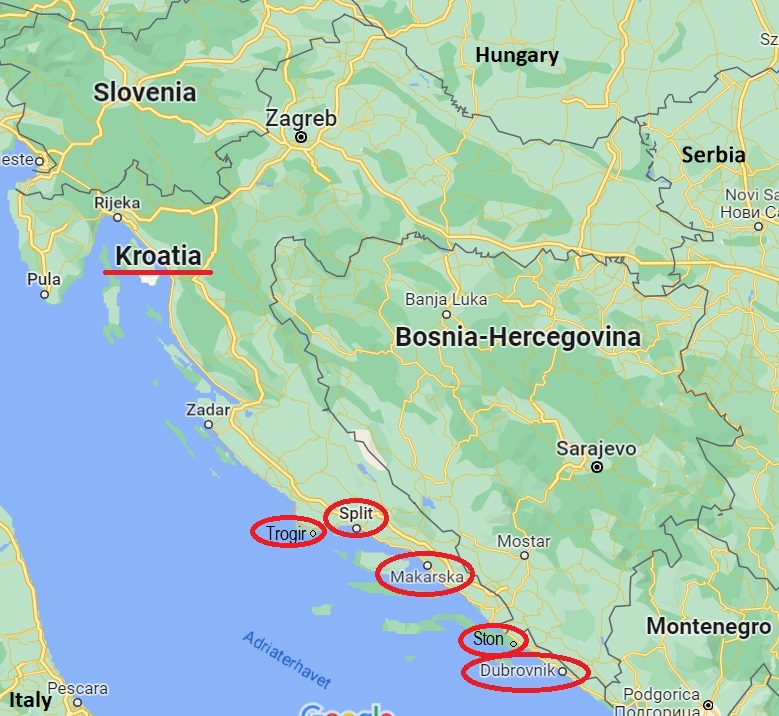
Croatia
Republic of Croatia has an area of 56,594 square kilometres and a population of about 4 million, most of whom are Catholics. It borders Slovenia to the northwest, Hungary to the northeast, Serbia to the east, Bosnia and Herzegovina, and Montenegro to the southeast, sharing a maritime border with Italy. Its capital, Zagreb.
The Croats arrived in the area in the 6th century. It was first internationally recognized as an independent state in 879, and retained its sovereignty for nearly two centuries. Croatia entered a union with Hungary in 1102. In 1527, faced with Ottoman conquest, the Croatian Parliament elected Ferdinand I of Austria to the Croatian throne. In the final days of World War I Croatia was merged into the Kingdom of Serbs, Croats and Slovenes (renamed the Kingdom of Yugoslavia in 1929).
On 25 June 1991, Croatia declared independence, which came wholly into effect on 8 October of the same year. The Croatian War of Independence was fought successfully for four years following the declaration.
I have visited Croatia in 2011, and in 2023 in connection with a Croatia, Bosnia-Hercegovina and Montenegro tour in March-April 2023. (See the full movie here).
Dubrovnik, 29. March 2023
In 1991, Croatia and Slovenia, which were republics within SFR Yugoslavia, declared their independence and was renamed to Republic of Croatia.
Dubrovnik has a Mediterranean climate. The bora wind blows cold gusts down the Adriatic coast between October and April. Winters are among the mildest of any Croatian city, with daytime temperatures around 13 °C in the coldest months.
Ston, 29. March 2023
Between 1461 and 1464 the longest defensive walls in Europe were built in Ston. It was one of the largest construction projects of the time with an original length of 7000 m, consisting of the walls of Ston and Little Ston. The Great Wall consists of three fortresses, and the walls and fortresses are flanked by 10 rounds of 31 squares and 6 semi-circular bastions. The complex defense corps has been shaped over the course of four centuries, due to the development of weapons.
We stopped in Ston for a lunch break before continuing to our hotel near Makarska.
Split, 30. March 2023 (Coming soon)
Split is the second-largest city of Croatia, the largest city in Dalmatia and the largest city on the Croatian coast, with a population of about 176,000. It is an intraregional transport hub and popular tourist destination, the city is linked to the Adriatic islands and the Apennine Peninsula.
The city was founded as the Greek colony of Aspálathos in the 3rd or 2nd century BC, and in 305 AD it became the site of the Palace of the Roman emperor Diocletian, which today forms about half the old town of Split, Croatia. The structure is massive and more resembles a large fortress: about half of it was for Diocletian’s personal use, and the rest housed the military garrison.
We stopped in Spit for a few hours to see the palace and local market.
Trogir, 30. March 2023 (Coming soon)
Since 1997, the historic center of Trogir has been included in the
UNESCO list of World Heritage Sites for its Venetian architecture, and is one of the best preserved medieval towns in Europe.
Tiny medieval streets wind through the enchanting town revealing hidden restaurants
and eye-catching galleries. A wide seaside promenade snakes around the town, culminating
in a charming port full of sailboats
Dubrovnik, June 2011
Dubrovnik was our last stop on our Adriatic cruise before returning to Venice. After arrival we hired a taxi to drive us up to a viewpoint (instead of taking the cable car), and thereafter he drove us down to the old town. It was a hot day and the old town was crowded with tourists, so we found a small bar/restaurant by the sea outside the city wall.
We walked on top of the city wall and in the narrow streets before taking a bus back to our cruise ship.
